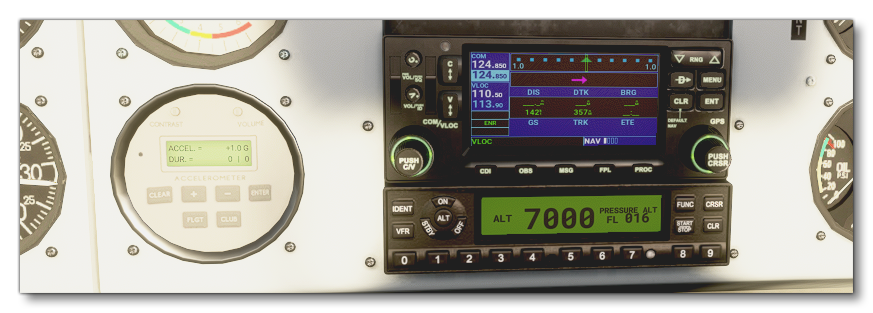INSTRUMENTS
The different instruments that are accessed by a user can be defined in multiple ways and then configured together in panels as a part of the virtual cockpit of an aircraft. In this section we discuss the setting up of the panels for an aircraft, as well as the different methods for creating the gauges that can be used in those panels.
The pages available in the section are as follows:
In general the panel.cfg file is the "glue" that connects the different instrument types to the actual aircraft within the simulation, and the panel.xml is used to add additional automated functionality to certain gauges (alerts, messages, electrics, etc...).
Instrument Types
In Microsoft Flight Simulator 2024, the aircraft instrumentation is split into three main categories, each of which is outlined below, and each of which has a growing complexity for setting up and getting working.
The External Cockpit
The external cockpit is the display that the user will see when they are flying or viewing the aircraft in 3rd person mode:

The various instruments on show in the external cockpit - as well as some that are used within glass-cockpits - are defined using the cockpit.cfg file, and you can find out more about this file from the following page:
Steam Gauges
Within the virtual cockpit, an aircraft will often have "steam" gauges:

These gauges need to be created as part of the aircraft Cockpit model, and will then be referenced and controlled using the various Model Behaviors templates.
Glass Cockpit Gauges
Within the virtual cockpit, an aircraft will also frequently have digital gauges, or what is known as "glass cockpit" displays:

These kinds of gauges come in three "flavours" depending on how you want to create them:
- WASM: WASM gauges are written using C++ code in an external editor (like Visual Studio). The main documentation for these kinds of gauges is extensive and can be found here: There are also a number of aircraft samples that make use of WASM modules and show how they can be set up and used, which you can find here:
- JavaScript/HTML/CSS: This method for creating gauges requires an HTML page to provide the gauge framework, a JS file to provide the gauge logic, and a CSS file to style the gauge. You can find additional information on the JavaScript used in these gauges here:
- The MSFS Avionics Framework: Many aircraft - both custom ones and those from Microsoft - use the MSFS Avionics Framework, which is a component based API specifically designed for making instrumentation using a React-like framework. More information is given below.
The MSFS Avionics Framework
Developers can use the MSFS Avionics Framework to build any type of glass cockpit on their own, however many aircraft included with Microsoft Flight Simulator 2024 use glass cockpit packages based on the MSFS Avionics Framework. These packages are already complete and are available for use by aircraft developers in their own aircraft. Most of these packages support plug-ins; these plug-ins allow aircraft developers to add functionality that is specific to their aircraft while still making use of the base instrument package. In some cases, plug-ins are required to make use of the package, for example to display engine instruments that differ from aircraft to aircraft, or to control aircraft-specific systems like a FADEC or autothrottle system that is unique to a specific installation.
In Microsoft Flight Simulator 2024, there are two versions of each of these packages – one that is fully backwards compatible with Microsoft Flight Simulator 2020, to support legacy aircraft that are directly moved to MSFS 2024, and a second that has been enhanced to be compatible with MSFS 2024 features and capabilities.
When building aircraft for Microsoft Flight Simulator 2024, we strongly recommend using the updated V2 packages of each of these instruments for the best user experience.
MSFS 2024 includes the following avionics packages that can be used by developers in their aircraft:
-
Garmin GNS 430/530
- Legacy/V1 Package Name:
workingtitle-instruments-garmin-gns - MSFS 2024 Package Name:
workingtitle-instruments-garmin-gns-v2- GNS430 VFS instrument location:
NavSystems/WTGNSv2/WT430/WT430.html - GNS530 VFS instrument location:
NavSystems/WTGNSv2/WT530/WT530.html
- GNS430 VFS instrument location:
- Legacy/V1 Package Name:
-
Garmin G1000 NXi
- Legacy/V1 Package Name:
workingtitle-instruments-g1000 - MSFS 2024 Package Name:
workingtitle-instruments-g1000-v2- PFD VFS instrument location:
NavSystems/WTG1000v2/PFD/WTG1000_PFD.html - MFD VFS instrument location:
NavSystems/WTG1000v2/MFD/WTG1000_MFD.html
- PFD VFS instrument location:
- Legacy/V1 Package Name:
-
Garmin G3X
- Legacy/V1 Package Name:
workingtitle-instruments-g3xtouch - MSFS 2024 Package Name:
workingtitle-instruments-g3xtouch-v2- VFS instrument location:
NavSystems/G3XTouchv2/G3XTouch.html
- VFS instrument location:
- Legacy/V1 Package Name:
-
Garmin G3000
- Legacy/V1 Package Name:
workingtitle-instruments-g3000 - MSFS 2024 Package Name:
workingtitle-instruments-g3000-v2- PFD VFS instrument location:
NavSystems/WTG3000v2/PFD/WTG3000_PFD.html - MFD VFS instrument location:
NavSystems/WTG3000v2/MFD/WTG3000_MFD.html - GTC VFS instrument location:
NavSystems/WTG3000v2/GTC/WTG3000_GTC.html
- PFD VFS instrument location:
- Legacy/V1 Package Name:
-
WT21 (this closely resembles the Proline 21)
- Legacy/V1 Package
Name: workingtitle-instruments-wt21 - MSFS 2024 Package Name:
workingtitle-instruments-wt21-v2- PFD VFS instrument location:
WT21v2/PFD/WT21_PFD.html - MFD VFS instrument location:
WT21v2/MFD/WT21_MFD.html - FMS VFS instrument location:
WT21v2/FMC/WT21_FMC.html
- PFD VFS instrument location:
- Legacy/V1 Package
-
Primus Epic 2
- Legacy/V1 Package Name:
workingtitle-instruments-epic2 - MSFS 2024 Package Name:
workingtitle-instruments-epic2-v2- PFD VFS instrument location:
NavSystems/Epic2v2/PFD/Epic2PFD.html - Upper MFD VFS instrument location:
NavSystems/Epic2v2/MFD/UpperMFD/Epic2UpperMfd.html - Lower MFD VFS instrument location:
NavSystems/Epic2v2/MFD/LowerMFD/Epic2LowerMfd.html - TSC VFS instrument location:
NavSystems/Epic2v2/TSC/Epic2Tsc.html
- PFD VFS instrument location:
- Legacy/V1 Package Name:
-
UNS-1
- Legacy/V1 Package Name:
workingtitle-instruments-uns-1lw - MSFS 2024 Package Name:
workingtitle-instruments-uns-1lw-v2- VFS instrument location:
NavSystems/WTUns1v2/WTUns1.html
- VFS instrument location:
- Legacy/V1 Package Name:
Many of these packages include multiple instruments, for example separate instruments for the PFD, MFD, CDU, etc, and have specific panel.cfg and panel.xml options that are detailed in the MSFS Avionics Framework documentation, here:
NOTE: This framework is not covered by the standard SDK documentation as it is already extensively documented at the link above.
Tutorials
There are tutorials available to help with creating the different glass-cockpit gauges and steam gauges available from the following pages: